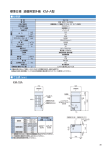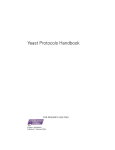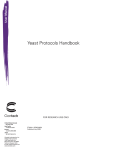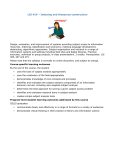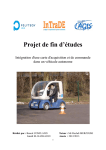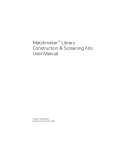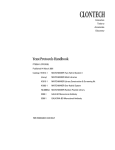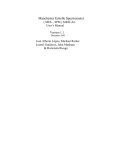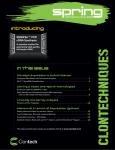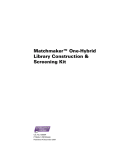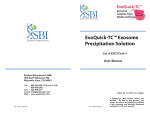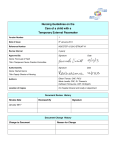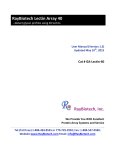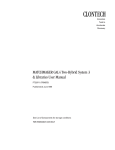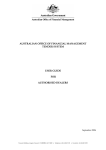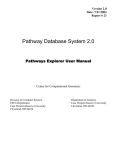Download Matchmaker™ Gold System FAQs
Transcript
Matchmaker™ Gold System FAQs Protein Interactions Find out more about our latest high-stringency yeast two-hybrid system Principles of Yeast Two-Hybrid Systems GAL4 AD What is the two-hybrid premise? Yeast two-hybrid technology (Y2H) is used primarily to discover de novo protein-protein interactions. Since it was invented in 1989 by Fields and Song1, more than 28,000 publications have cited its use to discover interactions in nearly every imaginable biological pathway. In the Matchmaker Gold Yeast Two-Hybrid System, your target protein of interest is fused to the DNA-binding domain (DNA-BD) of the yeast GAL4 protein to create a “bait” protein. By itself, this fusion protein cannot activate transcription but is able to bind the GAL4-responsive promoters positioned upstream of 4 reporter genes. Interacting partner proteins, often in the form of a library, are expressed as fusions to the transcriptional activation domain (AD) of yeast GAL4 to create “prey” proteins. When prey proteins interact with the bait protein, GAL4 activity is restored and expression of one or more reporter proteins is activated (Figure 1). Prey Bait GAL4 DNA-BD GAL Promoter 5' mRNA Figure 1. Yeast two-hybrid system design. Library-derived, transcription-activating prey fusion proteins that interact with the DNA-binding bait fusion protein activate the expression of reporter genes. Promoters Reporter Genes Aureobasidin A Resistance M1 a-Galactosidase M1 Histidine Biosynthesis 1. Fields, S. and Song, O. (1989) Nature 340(6230):245–247. G1 Why use yeast? Yeast cells provide an in vivo eukaryotic system that has the handling and easeof-use benefits of prokaryotic bacteria. For several important reasons, S. cerevisiae has been the favored two-hybrid host organism since the inception of this now common technique. Protein expression in yeast allows tertiary protein structures to form, provides a neutral internal pH, and produces the disulfide bonds and other post-translational modifications common to other eukaryotes. These features are important for maintaining native protein structures to promote authentic proteinprotein interactions. Additionally, yeast can be easily manipulated and its genome has been completely sequenced. Also, G2 Adenine Biosynthesis Figure 2. Four reporters give Matchmaker Gold its high stringency. libraries can be made very easily and directly in yeast through homologous recombination. Mammalian two-hybrid systems are ideal for confirmation of yeast two-hybrid results, but they are not very amenable to library screening due to poor ease-of-use and high background. What is the difference between false positives and background growth? Yeast two-hybrid systems that utilize only the HIS3 nutritional reporter to screen for protein-protein interactions often generate a high number of (i) background colonies and (ii) false positives. Why is it important to use multiple two-hybrid reporters? Multiple reporters for Y2H interactions serve to minimize the emergence of false positives, as explained in the following question. Background colonies are the result of leaky expression of the nutritional reporter or overly dense plating, whereas false positives are caused by prey proteins that, independently of the bait, have the ability to recognize and bind sequences upstream of the reporters. Clontech Laboratories, Inc. A Takara Bio Company www.clontech.com United States/Canada: +1.800.662.2566 • Asia Pacific: +1.650.919.7300 • Europe: +33.(0)1.3904.6880 • Japan: +81.(0)77.543.6116 For Research Use Only. Not for use in diagnostic or therapeutic procedures. Not for resale. Clontech, the Clontech logo, and all other trademarks are the property of Clontech unless noted otherwise. ©2009 Clontech Laboratories, Inc. FL912914 RNA Pol II Matchmaker™ Gold System FAQs Protein Interactions …continued Background colony growth is not possible with Matchmaker Gold due to the potency and stability of Aureobasidin A, a novel yeast two-hybrid antibiotic that very effectively kills all non-resistant cells. Additionally, Matchmaker Gold reduces false positives because any independent binding of a prey protein would need to occur at 3 different recognition sequences and activate all 4 reporters. Matchmaker Gold is the only yeast two-hybrid system with four genuine reporters controlled by three different bait recognition sequences/ promoters (Figure 2). Why do I need to test my bait for auto-activation? If your bait is a eukaryotic transcription factor, there is a possibility that it will activate the yeast reporters by itself in the absence of an interacting prey protein. This is termed auto-activation and is easily tested by checking for growth of the bait strain on selective media containing Aureobasidin A (as described in the Matchmaker Gold User Manual). If your bait auto-activates the reporters, you can still perform a two-hybrid screen but you must first remove the transcriptional activation domain (usually a run of acidic residues) from the bait construct. For example, the murine p53 fragment that is used as a positive control in the Matchmaker Gold System has had the first 71 amino acids removed. The N-terminus of this protein would otherwise contain a transcriptional activation domain. Can my bait be a transmembrane protein? Yes, but the two-hybrid system is generally limited to investigating interactions between cytoplasmic domains of the proteins. Since the Matchmaker Gold reporters are located in the cell nucleus, bait-prey interactions must also occur Clontech Laboratories, Inc. A Takara Bio Company www.clontech.com in the nucleus in order for them to be detected. As long as your protein folds properly and localizes to the nucleus (all Matchmaker vectors add nuclear localization signals to the bait and prey proteins), you should be able detect interactions with proteins in the library. It is usually advisable to remove the signal peptide and the transmembrane domain from your bait. There are numerous examples in the literature showing two-hybrid interactions with transmembrane proteins, see below: • Hopkinson, S.B. & Jones, J.C. (2000) Mol. Biol. Cell. 11(1):277–286. • Traweger, A. et al. (2002) J. Biol. Chem. 277(12):10201–10208. • Tian, X.Y. et al. (2001) Reproduction. 121(6):873–880. • Daniel, J.M. & Reynolds, A.B. (1999) Mol. Cell. Biol. 19(5):3614–3623. • Rochdi, M.D. et al. (2004) J. Biol. Chem. 279(18):18981–18989. What minimum and maximum sizes of proteins that have been detected using yeast two-hybrid analysis? Proteins as small as eight amino acids2 and as large as 750 amino acids3 have been used successfully in yeast two-hybrid studies. 2. Heery, D.M. et al. (1997) Nature 387(6634):733–736. 3. Schaefer B.C., Ed. (1997) Gene Cloning and Analysis: Current Innovations, (Horizon Scientific Press), pp 11–28. Culturing Yeast What is the difference between YPDA and YPD medium? YPD stands for “Yeast Peptone Dextrose” broth, and is a rich medium that contains an ideal mixture of amino acids, salts, dextrose (glucose), and other nutrients that enable yeast to grow rapidly. YPDA is the same as YPD except for the addition of 120 mg/L adenine hemisulfate, which prevents yeast strains that harbor the ADE2 mutant allele from turning pink/ red (see below). In Clontech’s YPDA, the final concentration of adenine hemisulfate is 3X higher than the concentration used in standard protocols (40 mg/L). If you use media from other sources your Matchmaker yeast strains may still turn pink/red. What are SD media and dropout supplements? Minimal media that is routinely used for culturing S. cerevisiae is called “synthetically defined” medium or SD. Clontech’s SD base supplies everything that wild-type yeast need to survive, including carbon and nitrogen sources, but lacks essential amino acids required by mutant strains. Selected essential amino acids are added to SD base to create specific minimal media, and premixed versions are available in Clontech’s Yeast Media Pouches and Yeast Media Sets. Alternatively you can purchase SD Base and selected amino acid dropout supplements (DO) separately, to suit individual needs. Specific minimal media are used to select for the growth of yeast that contain specific plasmids or which are expressing activated reporter genes. For example, SD Base mixed with the -Leu/-Trp DO Supplement is used to select for the Matchmaker bait and prey plasmids. SD/-Leu/-Trp DDO (double DO) is so called because the medium includes every essential amino acid except for leucine and tryptophan which are omitted, or dropped-out, from the formulation. Cells harboring bait and prey plasmids are able to grow because the plasmids encode tryptophan and leucine biosynthesis genes, respectively, which are otherwise absent from the parental yeast strain (e.g. Y2HGold). Various other dropout supplements are also available. Matchmaker™ Gold System FAQs Protein Interactions …continued What is Aureobasidin A and how is it used with Matchmaker Gold? Matchmaker Gold Systems are unique because they use the AUR1-C gene as a novel reporter which confers resistance to Aureobasidin A (AbA), a potent antibiotic that is toxic to S. cerevisiae. Resistance to this highly stable antifungal depsipeptide allows straightforward Y2H library screening to be achieved without the optimization that is otherwise required when using nutritional selection alone (e.g. HIS3). Can I use X-Gal instead of X-a-Gal for blue white screening with the Matchmaker System? No, X-Gal and X-a-Gal are not the same. The former is a substrate for the E. coli enzyme ß-galactosidase (lacZ), while the latter is a substrate for the yeast enzyme alpha-galactosidase (Mel1p). X-a-Gal is used in the Matchmaker Gold System as a primary reporter for blue/white colony screening, since Mel1p is secreted from the yeast following protein-protein interactions that activate the MEL1 gene. Why do my yeast colonies sometimes turn pink/red when grown on YPD medium? The red pigment exhibited by ADE2 mutants is a purine precursor which accumulates in ADE2 or ADE1 strains if they are grown in medium low in adenine. Clontech recommends that all its yeast strains be grown in YPDA, which has been supplemented with 120 mg/L adenine hemisulfate to avoid accumulation of this pigment. The pigment is not wellcharacterized, but some chemical analyses were published in 19674. The pigment appears to accumulate in the vacuole5 and fluoresces in 450–490 nm light. 4. Smirnov, M. N. et al. (1967) Biochem. Biophys. Res. Comm. 27(3):299–304. 5. Weisman, L.S. et al. (1987) J. Cell Biol. 105(4):1539–1547. Clontech Laboratories, Inc. A Takara Bio Company www.clontech.com My agar media failed to set properly, what could cause this? Assuming the correct amount of agar was added (20 g/L) this can be caused by a combination of excessive autoclaving and low pH. Some sources of purified water are acidic. If this is the case, adjust the solution to pH 5.8 for minimal SD media, and to pH 6.5 for YPDA before autoclaving for 15 min at 121°C. Yeast Two-Hybrid Libraries What are “Mate & Plate™” libraries? Mate & Plate libraries are pre-aliquoted libraries that have been pretransformed into MATa haploid yeast (Y187). They are compatible for mating with yeast MATa two-hybrid reporter strains, Y2HGold and AH109, used to express bait constructs. Simply grow your Y2HGold bait culture overnight in SD/-Trp, the next day mix with one vial of library, and then after a further overnight incubation period to allow mating to occur, spread the diploid cells on SD/-Leu/-Trp/X-aGal/AbA to select for colonies that harbor Y2H interactions. How do I make my own library? We strongly recommend using our Make Your Own “Mate & Plate™” Library System. There is no simpler way to make a yeast two-hybrid library, and no easier way to screen it than the Mate & Plate method. I have a minimal amount of starting material can I still make my own library? Yes. Since the Make Your Own “Mate and Plate” Library System uses SMART technology for cDNA synthesis, it is possible to start from limiting amounts of material. For example, you can create a library from as little as 100 ng of total RNA as the starting material. How can I determine if my current library will work with Matchmaker Gold? We have not tested yeast two-hybrid libraries from other sources, but in principle, any library will work with Matchmaker Gold if the prey (library) vector can be selected for using a LEU2 marker. Does Clontech have a custom service for yeast two-hybrid libraries? Yes. Clontech offers a service for manufacturing custom made “Mate & Plate Libraries.” Contact our Technical Support Department at [email protected] for details. Clontech does not, however, provide a library screening service. Visit Visit sit our website for more details! click here…




